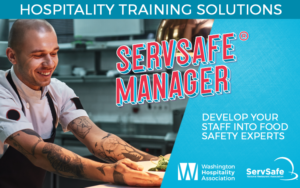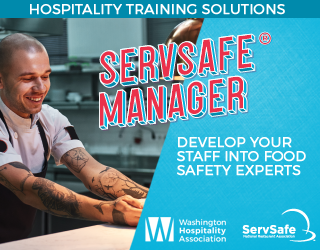By Anthony Anton, Washington Hospitality Association President & CEO
What would you do to save $15,000 today?
Your brain may immediately jump to renegotiating costs with your suppliers, but what if you could control costs by keeping employees safer? Here’s how to start:
[expander_maker id=”1″ more=”Read more” less=”Read less”]
Step 1: Pay attention to your Mod.
Reducing your Experience Modification Factor, also called your Experience Mod or just Mod, can save up to $25,000 a year on a $100,000 premium – just by dropping from 1.0 to 0.75. For a restaurant with 20 full-time equivalent employees, a Mod of 1.0 equals an annual cost of $16,700. Reducing that to 0.75 would cut about $4,000 per year.
Washington’s Department of Labor & Industries calculates your company’s modification factor using a rating plan that predicts how much better or worse your company’s claim costs are likely to be compared to the benchmark based on your history.
A sound safety program, double-checking that your Mod is accurate, and quality training for managers can all help you reduce your Mod and maintain cost savings.
Step 2: Encourage a good reporting system.
Create a system in your business to quickly report a claim. This will get employees treated and back to work and then help move the claim to closure.
Having a solid reporting system in place will show your staff there are options available if an injury occurs. Workers compensation can have a reputation as being a paid vacation. A quality reporting system and clear understanding among your team members will help your employees succeed and may reduce fraudulent claims.
What does a solid reporting system look like? It’s one that empowers your managers and employees to work together to
1) Report incidents immediately to the supervisor;
2) Seek medical treatment as needed;
3) Complete an incident report and submit it immediately to L&I and, if you are in RETRO, to ERNwest, our third-party administrator;
4) Complete return to work paperwork; and
5) Complete a thorough incident analysis to prevent further injuries.
A solid reporting system is efficient and provides quick access to recovery for the employee and also moves the claim to closure for the business – a win-win.
Step 3: Love “Return to Work.”
Sometimes an injury does not allow an employee to perform the job they were hired to do. Nevertheless, bring recovering employees back to the workplace as soon as possible, keeping them engaged and completing small tasks.
According to The Journal of Workers’ Compensation Data, when employees get back into their workplace routines after an injury they are more likely to feel more supported, heal faster and get back to their regular duties more quickly.
The longer an employee is out of work because of an illness or injury, the less likely they are to return to work. Studies show that when an employee is out of work for more than six months, they have less than a 50 percent chance of ever returning to work, according to The Journal of Workers’ Compensation.
Injured and disabled employees can often return to work sooner when the employer has alternative light-duty transitional work available and makes physical accommodations as necessary.
This is when L&I’s Return to Work program becomes especially important, bridging the gap between unemployment and the ability to successfully re-enter the workplace.
Our industry is successful when our employees are successful.
Step 4: Be aware of what’s common.
Know the most common causes of injuries for your business type. Hotels typically see injuries from bodily reactions (if an employee was walking and felt his or her knee pop), falls and overexertion, according to Labor & Industries.
Restaurants commonly see injuries from cuts, falls, overexertion, bodily reactions and being struck by something, according to Labor & Industries.
Armed with this knowledge, what are simple investments you can make today that will save you thousands of dollars in the long run?
Non-slip shoes? Gloves? Group warm-up stretches before shift?
We are just as passionate about our team members as we are any other part of our business. Choose proactive steps today to keep them safe.
Learn more in the following pages about how to improve workplace safety. Wahospitality.org also has more information on safety, training and solutions to implement in your business today.
[/expander_maker]



















![[Class, May 20] ServSafe Manager, Kent](https://wahospitality.org/wp-content/uploads/2018/07/CALEND1-150x150.png)







